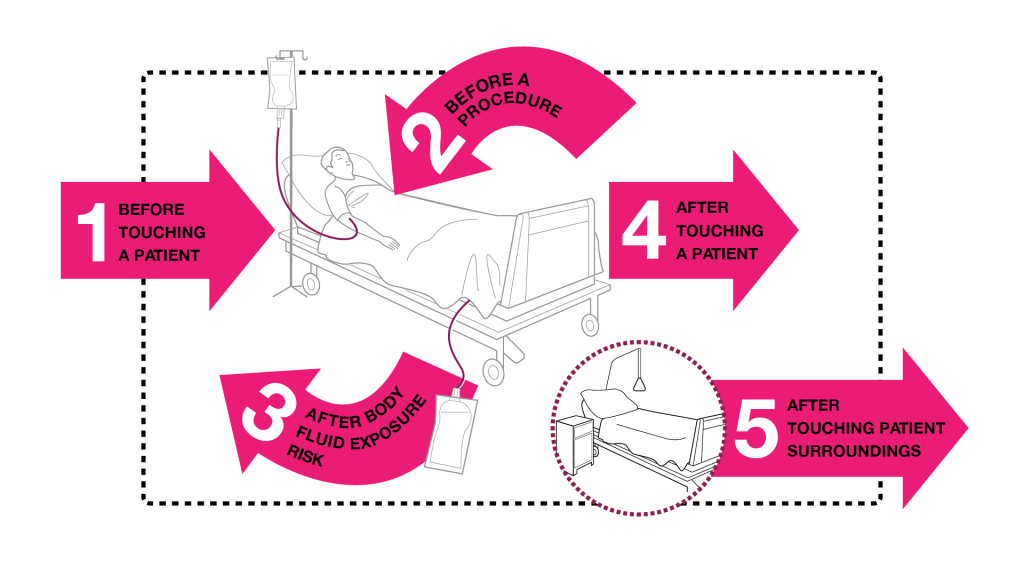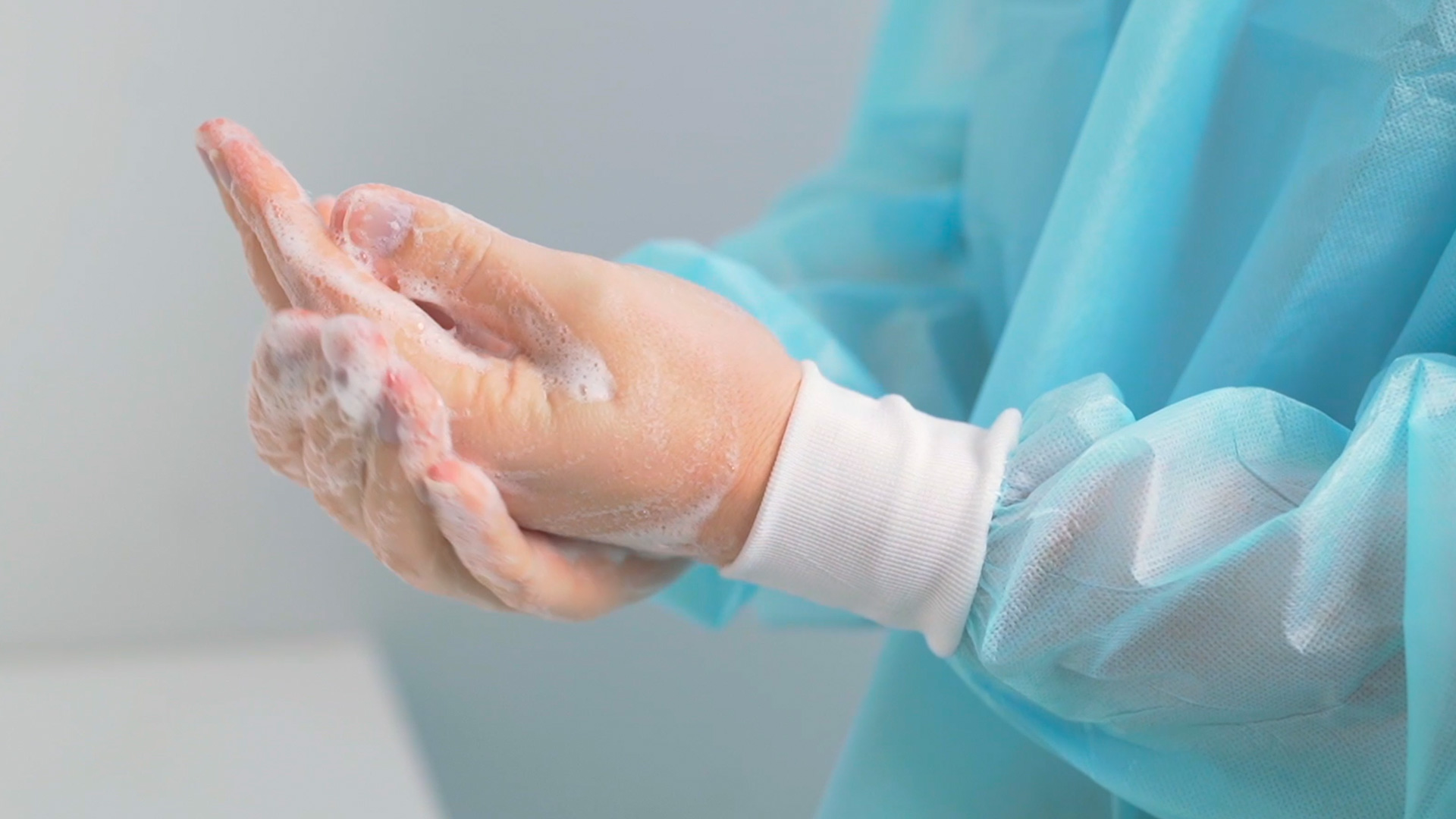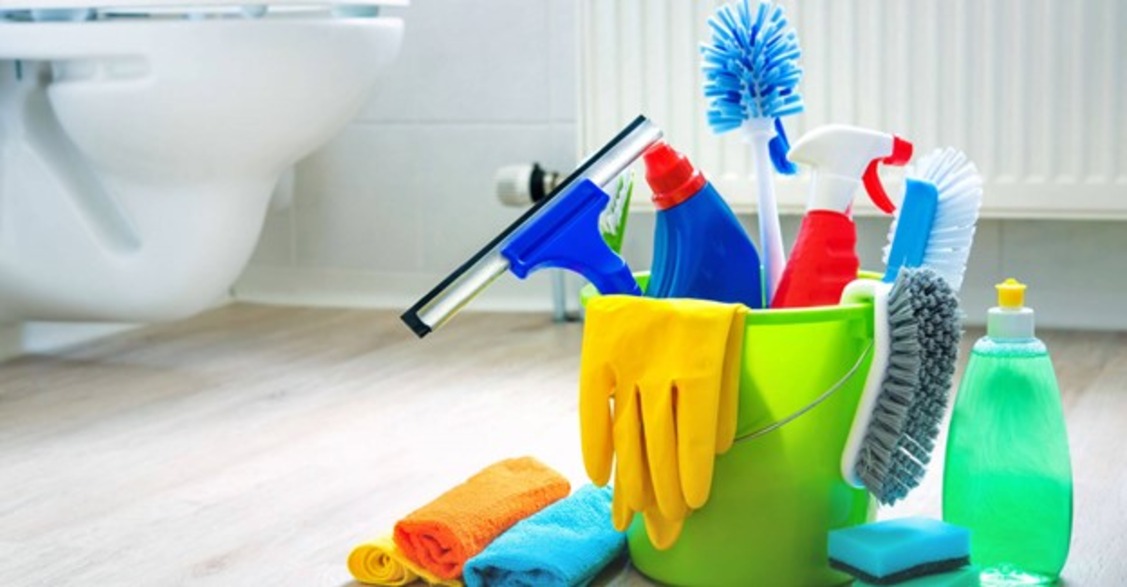Don't have time to read the full article?
Download a PDF copy with a full printable toolset attached.
What surface would hold these amounts of germs – a toilet seat, or a butcher’s block?
How about… your hands?
The WHO Guidelines on Hand Hygiene in Health Care1 estimated total bacteria counts on the hands of health care workers (HCWs) of up to 4.6 x 106 per cm2.
The bacteria on these HCWs’ hands increase the chance of health care associated infections (HAIs) in their patients.
The impact of HAI implies prolonged hospital stay, long-term disability, increased resistance of microorganisms to antimicrobials, massive additional financial burden, high costs for patients and their families, and excess deaths.2
These infections are especially dangerous for residential aged care facilities. The elderly are more susceptible to infection than younger adults due to the “immune deficiency of aging”, acquired from multiple risk factors in their bodies and environments.
Infection in the elderly is associated with greater morbidity and mortality, particularly pneumococcal pneumonia, influenza virus infections, and urinary tract infections secondary to a variety of pathogens.
The current situation: billions of bacteria on aged care workers’ hands, presenting a high risk of infection to a population of very vulnerable people.
What’s the solution?
Hand hygiene is the single most important element of strategies to prevent health care–associated infection.3
World Health Organization
The World Health Organisation (WHO) says the solution is better hand hygiene.
In the early 2000s, HAIs were causing hundreds of thousands of deaths globally, including in the healthcare systems of developed countries.
In 2009, WHO recommended an approach called ‘My five moments for hand hygiene’.
The National Hand Hygiene Institute (NHHI), under the Australian Commission on Safety and Quality in Health Care, adopted the WHO’s recommendation in a set of guidelines and resources.
High compliance rates to the Five Moments for Hand Hygiene can boost your facility’s hygiene results and impress auditors with your commitment to Infection Prevention and Control.
But most importantly, this approach will ensure your workers’ hands never adversely affect your customers’ health.
We’ve answered some of the most-asked questions about the Five Moments for Hand Hygiene in this article.
What are the Five Moments for Hand Hygiene?
The Five Moments for Hand Hygiene are a series of five key points in an interaction between a health care worker and their patient, where the worker should perform hand hygiene.
The WHO launched the approach in 2009 with their SAVE LIVES: Clean Your Hands global campaign.4
It’s described as an “evidence-based, user-centered concept… developed for measuring, teaching, and reporting hand hygiene adherence.”

Perform hand hygiene before touching a patient, to prevent harmful germs from transferring to the patient.
Perform hand hygiene before a procedure, to protect the patient from pathogens entering their body.
Note: Once hands are clean, don’t touch anything else before beginning the procedure.
Perform hand hygiene immediately after a body fluid exposure risk, to prevent body fluids from contaminating you and the healthcare area.
Note: This moment should still be observed when you are wearing gloves.
Perform hand hygiene immediately after a body fluid exposure risk, to prevent body fluids from contaminating you and the healthcare area.
Note: This moment should still be observed when you are wearing gloves.
Perform hand hygiene after touching a patient’s surroundings before leaving the area, to prevent contamination reaching outside of the patient zone.
Note: this moment is not always practical in a long-term care situation.
How are the Five Moments for Hand Hygiene Audited?
The NHHI does not require auditing on the Five Moments for Hand Hygiene in residential aged care facilities. However, it recommends Moments 1-4 for use in all direct care interactions.
This evidence-based procedure is high on the list of ways to prove compliance to Standard 3, iii (g):
Minimisation of infection-related risks through implementing: (i) standard and transmission-based procedures to prevent and control infection.
In fact, a 2016 inquiry into hand hygiene5 in residential aged care found:
- WHO recommends auditing Moments One to Four in residential aged care facilities, and
- the Centers for Disease Control and Prevention (USA) recommend “process indicators for monitoring compliance in RACFs: auditing one moment, ‘after contact with a resident or the objects/surfaces in the immediate vicinity of the resident’.”
There are significant benefits associated with implementing and recording the Five Moments for Hand Hygiene, to comply with Standard 3.
To get started, a self-audit can measure a compliance baseline to improve upon.
How to Self-Audit the Five Moments for Hand Hygiene
Begin a self-audit by using the WHO Hand Hygiene Self-Assessment Framework, a 30-minute question and answer tool, to gauge where you stand with hand hygiene.
The final score will show your hand hygiene level and give you direction of where to go next.
Once you have decided to implement the Five Moments for Hand Hygiene approach, use the NHHI Audit Data Collection Form, found on this page.
Compliance to the Five Moments for Hand Hygiene is recorded by an internal ‘observer’. This observer must understand the Five Moments for Hand Hygiene concept and be trained in and how to detect and notate hand hygiene indications.
This training is completed by:
- Parallel observation sessions with a previously validated observer, or6
- Watching and discussing the training film from the WHO implementation toolkit.
Using the Observation Form
- Start by filling in the details at the top with a pencil:

- Organisation
- Department/Ward
- Date
- Auditor (observer) Initials
- Session No. (if more than one session held)
- Start Time
- Then add the HCW category for the current data collection session. It’s best practice to use the NHHI Hand Hygiene Observation – Coding Classification Sheet, found here.
- During the observation, note down indications of hand hygiene and any actions that the HCW took by marking the boxes:

- Moment
- before touching the patient.
- before a procedure.
- after a body fluid exposure risk.
- after touching the patient.
- after touching the patient’s surroundings.
- Action
- Rub – HCW used alcohol-based hand rub.
- Wash – HCW washed hands with soap and water.
- Missed – Moment for hand hygiene observed but not performed.
- Glove (leave blank if no gloves used)
- On – HCW put gloves on.
- Off – HCW removed gloves.
- Cont. – HCW continued to wear the same pair of gloves.
- Add up the total moments and total correct moments, to be used for compliance percentages.
How to Embed the Five Moments for Hand Hygiene Culture
As in any value-driven company culture, the Five Moments for Hand Hygiene culture must be guided by leadership, through direction and example.
The WHO recommends these steps:7
Infrastructure
Implementing appropriate hand hygiene systems that give HCWs
- A safe, reliable water supply with easy access to soap and towels
- Alcohol-based hand sanitiser available at the point of care
Training
Regularly educating workers on
- The importance of hand hygiene
- The ‘My five moments for hand hygiene’ approach
- How to correctly handwash and use hand sanitiser
Evaluation
Implementing policies and procedures to ensure a continuous feedback loop and improve hand hygiene systems and performance.
Reminders
Reminders in the workplace of hand hygiene, from
- The example shown by a facility’s leadership
- Direct supervision
- Physical reminders such as signs and wall posters
Culture
Creating and maintaining an environment where it’s perceived as safe and valuable to raise issues around hygiene and the welfare of patients.
This could be done by
- Recruiting and rewarding for behaviors that promote hand hygiene
- Talking about hand hygiene as a leader
- Asking the team to contribute ideas on how to put the Five Moments of Hand Hygiene into practice
The Results from a Focus on Hand Hygiene
With full compliance to the Five Moments for Hand Hygiene method, the results could be immense:
- Millions of health care associated infections prevented,
- Billions of dollars made available for other health care improvements,
- And, most importantly, countless lives saved.
In your facility, infection control is your responsibility.
You can save lives, deliver great savings and a boosted reputation just by implementing and monitoring the simple Five Moments for Hand Hygiene method.
Want to implement the Five Moments for Hand Hygiene, but don’t know where to start with a hand hygiene system? Reach out to our Infection Control team today for help.
- WHO Guidelines on Hand Hygiene in Health Care: First Global Patient Safety Challenge Clean Care Is Safer Care. Geneva: World Health Organization; 2009. 5, Normal bacterial flora on hands. Available from: https://www.ncbi.nlm.nih.gov/books/NBK144001/
- WHO Guidelines on Hand Hygiene in Health Care: First Global Patient Safety Challenge Clean Care Is Safer Care. Geneva: World Health Organization; 2009. 3, The burden of health care-associated infection. Available from: https://www.ncbi.nlm.nih.gov/books/NBK144030/
- Hand hygiene is the single most important element of strategies to prevent health care–associated infection (HAI). World Health Organization. WHO guidelines for hand hygiene in health care. Geneva, Switzerland: World Health Organization; 2009.
- The Five Moments for Hand Hygiene were initially reported on in the 2007 paper, “‘My five moments for hand hygiene’: a user-centred design approach to understand, train, monitor and report hand hygiene” by H. Sax, B. Allegranzi, I. Uckay, E. Larson, J. Boyce, & D. Pittet.
- Hand Hygiene Monitoring in Residential Aged Care: National and International Perspectives with Relevance to Australian Facilities
https://www.idhjournal.com.au/article/S2468-0451(16)30142-0/fulltext - Sax H, Allegranzi B, Chraïti MN, Boyce J, Larson E, Pittet D. The World Health Organization hand hygiene observation method. Am J Infect Control. 2009 Dec;37(10):827-34. doi: 10.1016/j.ajic.2009.07.003. PMID: 20004812.
- A Guide to the Implementation of the WHO Multimodal Hand Hygiene Improvement Strategy
https://www.who.int/infection-prevention/publications/hh_implementation-guide/en/
Don't have time to read the full article?
Download a PDF copy with a full printable toolset attached.






